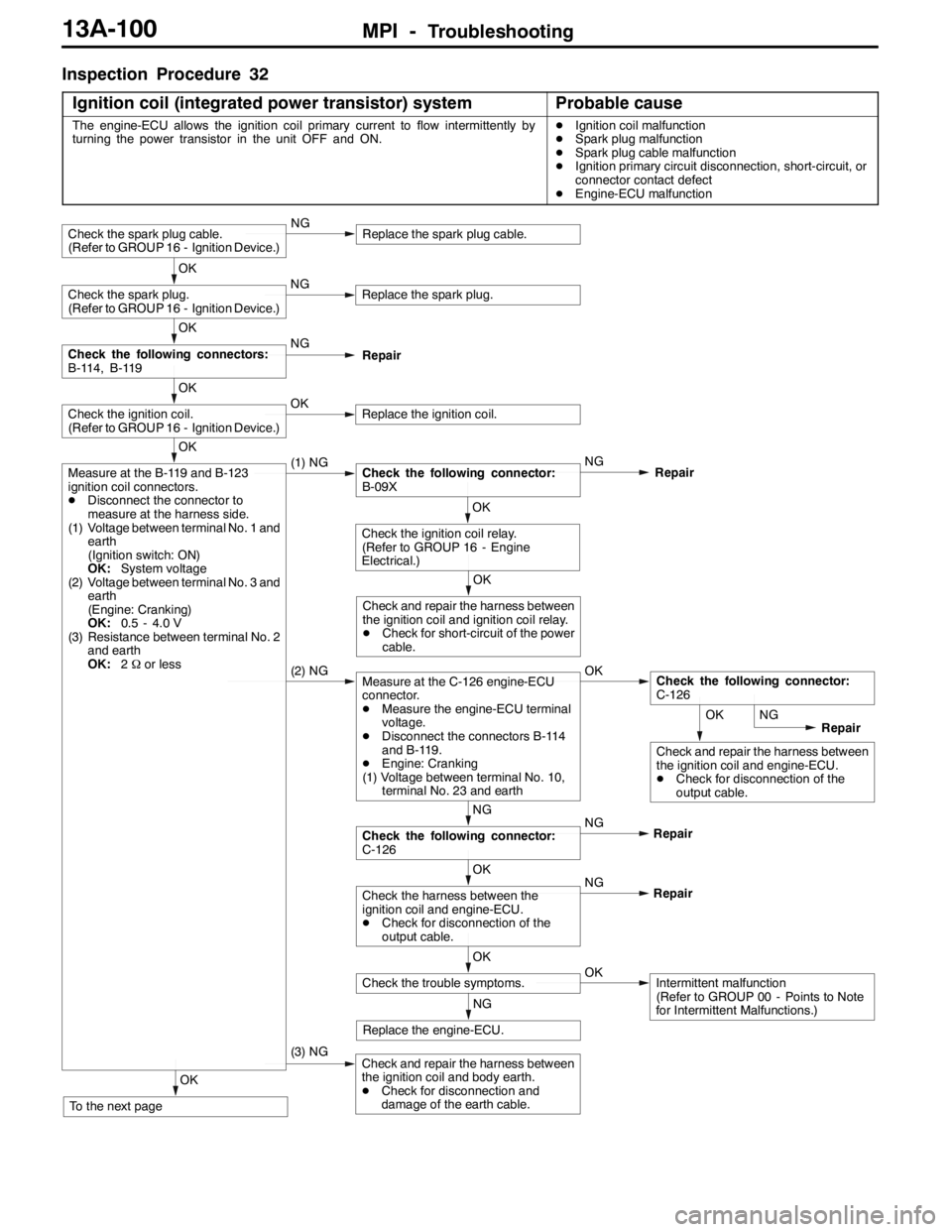Page 632 of 1449

MPI -Troubleshooting13A-100
Inspection Procedure 32
Ignition coil (integrated power transistor) system
Probable cause
The engine-ECU allows the ignition coil primary current to flow intermittently by
turning the power transistor in the unit OFF and ON.DIgnition coil malfunction
DSpark plug malfunction
DSpark plug cable malfunction
DIgnition primary circuit disconnection, short-circuit, or
connector contact defect
DEngine-ECU malfunction
OK
Check and repair the harness between
the ignition coil and engine-ECU.
DCheck for disconnection of the
output cable.
OK
To the next page
(3) NGCheck and repair the harness between
the ignition coil and body earth.
DCheck for disconnection and
damage of the earth cable.
NG
Replace the engine-ECU.
OK
Check the trouble symptoms.OKIntermittent malfunction
(Refer to GROUP 00 - Points to Note
for Intermittent Malfunctions.) NG
OK
Check the harness between the
ignition coil and engine-ECU.
DCheck for disconnection of the
output cable.Repair NG
NG
Check the following connector:
C-126Repair
(2) NGMeasure at the C-126 engine-ECU
connector.
DMeasure the engine-ECU terminal
voltage.
DDisconnect the connectors B-114
and B-119.
DEngine: Cranking
(1) Voltage between terminal No. 10,
terminal No. 23 and earthOKCheck the following connector:
C-126
OK
Check and repair the harness between
the ignition coil and ignition coil relay.
DCheck for short-circuit of the power
cable.
OK
Check the ignition coil relay.
(Refer to GROUP 16 - Engine
Electrical.)
OK
Measure at the B-119 and B-123
ignition coil connectors.
DDisconnect the connector to
measure at the harness side.
(1) Voltage between terminal No. 1 and
earth
(Ignition switch: ON)
OK:System voltage
(2) Voltage between terminal No. 3 and
earth
(Engine: Cranking)
OK:0.5 - 4.0 V
(3) Resistance between terminal No. 2
and earth
OK:2Ωor less(1) NGCheck the following connector:
B-09XNG
Repair
OK
Check the ignition coil.
(Refer to GROUP 16 - Ignition Device.)OKReplace the ignition coil.
OK
Check the following connectors:
B-114, B-119NG
Repair
OK
Check the spark plug.
(Refer to GROUP 16 - Ignition Device.)NGReplace the spark plug.
Check the spark plug cable.
(Refer to GROUP 16 - Ignition Device.)NGReplace the spark plug cable.
NG
Repair
Page 633 of 1449
MPI -Troubleshooting13A-101
NG
Replace the engine-ECU.
Check the trouble symptoms.OKIntermittent malfunction
(Refer to GROUP 00 - Points to Note
for Intermittent Malfunctions.)
OK
Check the harness between the
ignition coil and engine-ECU.
DCheck for damage of the output
cable.NG
Repair
OK
Check the harness between the
ignition coil and ignition coil relay.
DCheck for damage of the power
cable.NG
Repair
From the previous page
Page 634 of 1449
![MITSUBISHI LANCER EVOLUTION 2007 Service Repair Manual MPI -Troubleshooting13A-102
DATA LIST REFERENCE TABLE
NOTE
*1. In a new Vehicle [driven approximately 500 km or less], the air flow sensor output frequency time
is sometimes 10% longer than the standa MITSUBISHI LANCER EVOLUTION 2007 Service Repair Manual MPI -Troubleshooting13A-102
DATA LIST REFERENCE TABLE
NOTE
*1. In a new Vehicle [driven approximately 500 km or less], the air flow sensor output frequency time
is sometimes 10% longer than the standa](/manual-img/19/57084/w960_57084-633.png)
MPI -Troubleshooting13A-102
DATA LIST REFERENCE TABLE
NOTE
*1. In a new Vehicle [driven approximately 500 km or less], the air flow sensor output frequency time
is sometimes 10% longer than the standard time.
*2. The injector drive time represents the time when the cranking speed is at 250 r/min or below when
the power supply voltage is 11 V.
*3. In a new vehicle [driven approximately 500 km or less], the injector drive time is sometimes 10%
longer than the standard time.
*4. In a new vehicle [driven approximately 500 km or less], the step of the stepper motor is sometimes
30 steps greater than the standard value.
Item
No.Inspection
itemInspection contentsNormal conditionInspection
procedure
No.Reference
page
11Oxygen
sensor
(front)Engine: After having
warmed up
(Air/fuel mixuture is
made leaner whenWhen at 4,000 r/min,
engine is suddenly de-
celerated200 mV or lessCode No.
P013013A-24
madeleanerwhen
decelerating, and is
made richer when rac-
ing.)When engine is sud-
denly raced600 - 1,000 mV
Engine: After having
warmed up
(The oxygen sensor
(front) signal is used
tochecktheair/fuel
Engine is idling400 mV or less↔
600 - 1,000 mV
(Varies)
to check the air/fuel
mixture ratio, and
control condition is
also checked by the
engine-ECU.)2,500 r/min
12Air flow
sensor*1DEngine coolant
temperature:
Idle operation17 - 43 Hz--
sensor*1temperature:
80 - 95_C
DLightningandall
2,500 r/min40 - 100 Hz
DLightning andall
accessories:
OFF
DTransmission:
NeutralAccelerationAccording to ac-
celeration, fre-
quency is ampli-
fied.
13Intake air
temperature
sensor
Ignition switch: “ON”
or engine runningWhen intake air temper-
ature is - 20_C-20_CCode No.
P011013A-13
sensorWhen intake air tem-
perature is 0_C0_C
When intake air tem-
perature is 20_C20_C
When intake air tem-
perature is 40_C40_C
When intake air tem-
perature is 80_C80_C
Page 638 of 1449

MPI -Troubleshooting13A-106
Item
No.Reference
page Inspection
procedure
No. Normal condition Inspection contents Inspection
item
A1LOxygen
sensor
(front)Engine: After having
warmed up
(Air/fuel mixture is
made leaner whenWhen at 4,000 r/min,
engine is suddenly de-
celerated200 mV or lessCode No.
P013013A-24
madeleanerwhen
decelerating, and is
made richer when
racing.)When engine is sud-
denly raced600 - 1,000 mV
Engine: After having
warmed up
(By using oxygen
sensorcheckair/fuel
Idle operation400 mV or less↔
600 - 1,000 mV
(altered)
sensor, checkair/fuel
mixture as well as
control status by
engine-ECU)2,500 r/min
A2LOxygen
sensor
(rear)Engine: After having
warmed upWhen engine is sud-
denly raced0 and 600 - 1,000
mV alternate.Code No.
P013613A-27
8ALThrottle
position
sensor
DEngine: After
having warmed
up
Release the accelera-
tor pedal.8 - 16%Code No.
P012013A-21
sensor
(Throttle
position
opening
angle)up
DIgnition switch:
“ON” (Engine
stopped)Depress the accelera-
tor pedal gradually.Increase in re-
sponse to the
pedal depression
stroke.
Depress the accelera-
tor pedal fully.80 - 100%
NOTE
Items marked byLwill not displayed if service data is selected on the check mode.
Page 640 of 1449

MPI -Troubleshooting13A-108
Item
No.Reference
page Inspection
procedure
No. Normal condition Inspection contents Drive contents Inspection
item
21Fan
controllerRadiator fan
motor is
driven.Ignition switch: “ON”Fan motor rotates
at high speed.Procedure
No. 2413A-87
36Secondary
air control
solenoid
valveSolenoid valve
turns from
OFF to ON.Ignition switch: “ON”Sound of opera-
tion can be heard
when solenoid
valve is driven.Procedure
No. 2913A-96
37Condenser
fan (HI)Condensor
fan motor is
driven.Ignition switch: “ON”Fan motor rotates
at high speed.Procedure
No. 2513A-89
38Condenser
fan (LOW)Second air
control
solenoid valveIgnition switch: “ON”Fan motor rotates
at low speed.
CHECK AT THE ENGINE-ECU TERMINALS
TERMINAL VOLTAGE CHECK CHART
1. Connect a needle-nosed wire probe (test harness:
MB991223 or paper clip) to a voltmeter probe.
2. Insert the needle-nosed wire probe into each of the
engine-ECU connector terminals from the wire side, and
measure the voltage while referring to the check chart.
NOTE
(1) Make the voltage measurement with the engine-ECU
connectors connected.
(2) You may find it convenient to pull out the engine-ECU
to make it easier to reach the connector terminals.
(3) The checks can be carried out off the order given
in the chart.
Caution
Short-circuiting the positive (+) probe between a
connector terminal and earth could damage the
vehicle wiring, the sensor, engine-ECU or all of them.
Be careful to prevent this!
3. If voltmeter shows any division from standard value, check
the corresponding sensor, actuator and related electrical
wiring, then repair or replace.
4. After repair or replacement, recheck with the voltmeter
to confirm that the repair has corrected the problem.
Needle-nosed wire probe
Page 641 of 1449

MPI -TroubleshootingMPI -Troubleshooting13A-109
Engine-ECU Connector Terminal Arrangement
Terminal No.Check itemCheck condition (Engine condition)Normal condition
1No. 1 injectorWhile engine is idling after having warmed up,
suddenlydepresstheacceleratorpedal
From 11 - 14 V, momentarily
dropsslightly
14No. 2 injector
suddenlydepressthe accelerator pedal.drops slightly
2No. 3 injector
15No. 4 injector
3Fuel pressure control
solenoidvalve
Ignition switch: “ON”System voltage
solenoidvalve
Engine: Cranking→Idle operation
(within approximately 2 minutes or less)1 V or less→System voltage
4Stepper motor coil
Engine: Soon after the warmed up engine is
startedSystem voltage↔0-6V
(Changes repeatedly)
17Stepper motor coil
5Stepper motor coil
18Stepper motor coil
6EGR control solenoid
valve
Ignition switch: “ON”System Voltage
valve
While engine is idling, suddenly depress the
accelerator pedal.From system voltage,
momentarily drops
8A/C relayDEngine: Idle operation
DA/Cswitch:OFF→ON(A/Ccompressor
System voltage or momen-
tarily6Vormore→1VorDA/Cswitch:OFF→ON(A/Ccompressor
runs)tarily6Vor more→1Vor
less
9Purge control sole-
noidvalve
Ignition switch: “ON”System voltage
noidvalve
Engine: Idle operation1 V or less
10Ignition coil - No.1,
No.4Engine speed: 3,000 r/min0.3 - 3.0 V
23Ignition coil - No.2,
No.3
11Waste gate solenoid
valve
Ignition switch: “ON”System voltage
valve
Engine: After warm-up, idle operation
(When using premium gasoline)1 V or less
Page 646 of 1449

MPI -Troubleshooting13A-114
CHECK CHART FOR RESISTANCE AND CONTINUITY
BETWEEN TERMINALS
1. Turn the ignition switch to “LOCK” (OFF) position.
2. Disconnect the engine-ECU connector.
3. Measure the resistance and check for continuity between
the terminals of the engine-ECU harness-side connector
while referring to the check chart.
NOTE
(1) When measuring resistance and checking continuity,
a harness for checking contact pin pressure should
be used instead of inserting a test probe.
(2) Checking need not be carried out in the order given
in the chart.
Caution
If the terminals that should be checked are mistaken,
or if connector terminals are not correctly shorted
to earth, damage may be caused to the vehicle wiring,
sensors, engine-ECU and/or ohmmeter.
Be careful to prevent this!
4. If the ohmmeter shows any deviation from the standard
value, check the corresponding sensor, actuator and
related electrical wiring, and then repair or replace.
5. After repair or replacement, recheck with the ohmmeter
to confirm that the repair or replacement has corrected
the problem.
Engine-ECU Harness Side Connector Terminal Arrangement
Terminal No.Inspection itemNormal condition (Check condition)
1-12No. 1 injector2-3Ω(at 20_C)
14 - 12No. 2 injector
2-12No. 3 injector
15 - 12No. 4 injector
Page 647 of 1449

MPI -Troubleshooting13A-115
Terminal No. Normal condition (Check condition)Inspection item
3-12Fuel pressure control solenoid valve28 - 36Ω(at 20_C)
4-12Stepper motor coil (A1)28 - 33Ω(at 20_C)
17 - 12Stepper motor coil (A2)
5-12Stepper motor coil (B1)
18 - 12Stepper motor coil (B2)
6-12EGR control solenoid valve36 - 44Ω(at 20_C)
9-12Purge control solenoid valve22 - 26Ω(at 20_C)
11 - 1 2Waste gate solenoid valve62 - 74Ω(at 20_C)
13 - Body earthENGINE-ECU earthContinuity (0Ω)
26 - Body earthENGINE-ECU earth
53 - 12Secondary air control solenoid valve28 - 36Ω(at 20_C)
54 - 12Oxygen sensor heater (Rear)11 - 1 8Ω(at 20_C)
60 - 12Oxygen sensor heater (Front)4.5 - 8.0Ω(at 20_C)
72 - 92Intake air temperature sensor13 - 17 kΩ(When intake air temperature is - 20_C)
5.7 - 6.7 kΩ(When intake air temperature is 0_C)
2.3 - 3.0 kΩ(When intake air temperature is 20_C)
1.0 - 1.5 kΩ(When intake air temperature is 40_C)
0.56 - 0.76 kΩ(When intake air temperature is 60_C)
0.30 - 0.42 kΩ(When intake air temperature is 80_C)
83 - 92Engine coolant temperature sensor14 - 17 kΩ(When coolant temperature is - 20_C)
5.1 - 6.5 kΩ(When coolant temperature is 0_C)
2.1 - 2.7 kΩ(When coolant temperature is 20_C)
0.9 - 1.3 kΩ(When coolant temperature is 40_C)
0.48 - 0.68 kΩ(When coolant temperature is 60_C)
0.26 - 0.36 kΩ(When coolant temperature is 80_C)